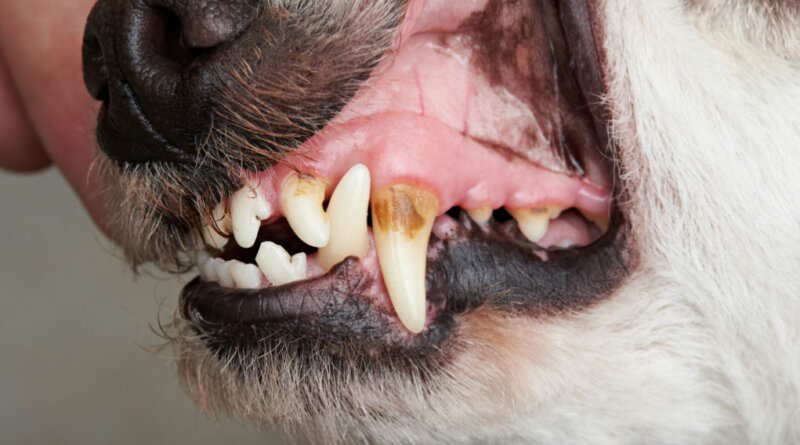Can Dogs Get Cavities? – Top Dog Tips
DID YOU KNOW that just like humans, dogs go through two sets of teeth in their lifetime?
Just as we had baby teeth when we were babies, they also have puppy teeth that are later replaced with adult teeth.
Plus, they have more teeth than humans! While we have 32 adult teeth, dogs have 42. Cool, right?
With that many choppers, the question is… can dogs get cavities, too?
In this article, let’s get to know more about this canine dental problem—how do dogs get cavities, how to get rid of dog cavities, and what to do if your dog has cavities.
Can Dogs Get Cavities?
Cavities, also known as caries or tooth decay, are usually caused by a combination of factors in an individual’s mouth.
And to answer the question, “Can dogs get cavities?…” Yes.
Just as humans get cavities, so do dogs too.
But our furry friends are actually less prone to getting cavities than us because of the difference in our diets.
While we love donuts, burgers, and pizzas (yes, for sweets and carbs!), a dog’s diet is mostly comprised of low amounts of sugar and acids.
Plus, their teeth structure is something to be thankful for, too. Because their teeth are pointed and mostly don’t sit tightly together, there isn’t much space for food debris to be trapped.
Their natural drooling also helps neutralize acids and wash away bacteria and any food leftovers from their mouth.
However, that’s not to say dogs are 100% safe from getting cavities. Having poor dental health is enough to cause cavities to build up.
And speaking of poor dental health, check out our podcast below on why maintaining good and proper dental health is important for our pets, too.
Dog Breeds Prone to Dental Diseases
Some breeds are also more predisposed to getting different dental diseases (and not just cavities, mind you!)
A study made by the Royal Veterinary College in the UK revealed just how prevalent diseases involving the teeth, gums, and other parts of the mouth in dogs are.
They also concluded that flat-faced or brachycephalic dogs and spaniel breeds are at greater risk of oral diseases and that this risk increases all the more as dogs get older.
A dog’s size might have something to do with its constant need for dental care too, as smaller breeds are said to be more prone to dental problems than larger and heavier breeds.
Toy Poodles, King Charles Spaniels, Greyhounds, and Cavalier King Charles Spaniels were named the most affected dog breed for oral diseases.
But not only them. You may also want to inspect your dog’s teeth now if you have the following breeds:
- Brussels Griffon
- English Bulldog
- French Bulldog
- Shih Tzu
- Lhasa Apso
- Pug
- Chihuahua
- Pomeranian
- Dachshund
- Yorkshire Terrier
But remember that as long as your pup has poor general health, eats carbs-rich food, has crowded teeth or has gaps between teeth and gums, has a low pH level in saliva, and has a weak tooth enamel caused by poor mineralization, they will definitely be at high risk in developing cavities.
Causes of Cavities in Dogs
Just like in humans, cavities in dogs are caused by plaque build-up from the bacteria consuming food debris in the mouth.
These plaque build-ups are acidic and, if left uncleaned for a period of time, will slowly eat away at the enamel (outer layer of teeth) leading up to small or big holes in the teeth, known as—you guessed it—cavities, caries, or tooth decay.
Later on, cavity holes can expose nerve endings in the teeth, which will make it painful for dogs to eat or drink.
Unlike what most people think, this decay can actually start happening on any part of the tooth, whether at the top or at the gum line.
Symptoms of Dog Cavities
Enough of asking yourself, “does my dog have a cavity?” because there are tell-tale signs you can surely watch out for.
Good thing, the symptoms of dog cavities are easily observable because they’re visible. Check your pooch’s teeth for the following indicators:
- Dark spot anywhere on the tooth
- Discoloration of teeth, especially near the gum area
- Noticeable tartar build-up
- Bad breath
- Bleeding from the mouth
- Reduced appetite or refusal to eat
- Abnormal chewing
- Excessive drooling
- Dropping food from the mouth
- Swelling or redness in or around the mouth
- Obvious pain/whimpering
Diagnosis of Dog Cavities
So what to do if your dog has cavities?
If you see one or many of the abovementioned symptoms, it’s best to visit your veterinarian for a dental checkup and treatment as soon as possible.
Much like how a dentist would check your tooth, the veterinary dentist will also conduct several tests to diagnose your dog’s teeth condition.
He or she will most likely do a visual exploration of your dog’s mouth.
It will involve tapping on possible cavities with a little hammer-like instrument to see whether the tooth is still hard or if it will yield.
An x-ray will also likely be ordered to see the extent of the damage.
Often, cavities are accompanied by other dental issues such as periodontal disease (gum disease). The vet dentist will likely look out for this too.
5 Stages of Cavities in Dogs
Cavities are categorized and diagnosed in different stages.
Stage 1 is where only the enamel or the outer layer of the tooth is affected.
The 2nd Stage is where not only the enamel is affected, but the dentin too (or the layer beneath the enamel.)
When in contact with hot or cold and sticky or acidic food, it will cause sensitivity.
In Stage 3, the decay will have reached the pulp chamber too, or the centermost part of the tooth.
This part houses the pulp or the soft tissue in the tooth where connective tissue, nerves, and blood vessels are located.
When a cavity reaches the pulp, the tooth begins to decay faster, which might lead to inflammation, swelling, and pain.
If the cavity progresses further, it will reach the 4th Stage where the structural crown is noticeably damaged.
Either it can be resolved by getting a root canal treatment or complete extraction of the teeth.
And in the final stage, Stage 5, the roots still remain but are exposed and a majority of the crown is lost.
Treatment for Dog Cavities
If you’re wondering if dogs can get fillings, they certainly do!
But of course, the treatment will depend on the severity of your dog’s cavity.
There are 2 things a vet dentist can do: a restorative dental procedure and/or routine care for prevention.
Restorative Dental Procedure
Stages 1 and 2 will require an amalgam filling to restore the crown after removing the affected parts of the enamel and/or the dentin.
A root canal procedure will be required for a Stage 3 diagnosis. Here, the root canal will be disinfected and scrubbed, before being filled.
This will end in the restoration and the sealing of the crown.
While in the final stages of the cavity, in Stages 4 and 5, tooth removal will likely be the solution.
This is because the damage may already be too severe to save the tooth.
The surrounding teeth near the affected area might also be treated with a sealant to ensure that the cavity will not spread in the mouth any further.
Procedure Recovery After-care
Any dental procedure, whether getting fillings or extraction, requires special aftercare, although they can heal quite fast.
Follow-up appointments with the vet dentist are still necessary though to make sure that they are healing well and that nothing untoward is happening.
You would also have to monitor your dog’s oral health from here on.
The vet dentist may also prescribe a specific toothpaste for your dog, along with tooth-strengthening and cleaning products.
Also, remember to ask your vet’s advice on what diet your dog should be taking to further preserve his oral health.
Routine Care for Prevention of Cavities
Dental routine care for dogs is recommended prior to getting any oral disease, more so when they already have a history.
A minimum of once per year visit is advised to conduct a professional dental exam and cleaning treatment.
This will not only ensure a thorough hygiene cleaning; they’ll also have the opportunity to spot any decay or disease at the onset if ever there is one.
At-home care is equally important. Brushing your pet’s teeth at least 2 to 3 times a week should be enough to remove any bacteria buildup in their mouth.
Make sure to use specialized toothbrushes and toothpaste to encourage them to look forward to this activity.
In this podcast, Dr. Lyndsey Kingsley of BetterVet discussed why brushing your dog’s teeth can help you save thousands of bucks and your dog’s life, too!
Estimate Cost for Dog Dental Procedures
Speaking of thousands, let us give you a heads-up: dental procedures for dogs can rack up quite the bill.
This is where your pet insurance will come in handy. Most insurance for dogs and cats covers dental procedures so you can rest assured that your dog’s health and expenses will be taken care of.
On average, routine dental cleaning for dogs alone can already cost from $300 to $700 across the country. X-rays and anesthesia, which are both necessary for this procedure, are usually already included in that amount.
However, any additional treatment your vet dentist may recommend isn’t, so better prepare your wallet for the expense.
If your dog doesn’t have insurance yet, check out our beginner’s guide to getting insurance for your pet.
Remember that the sooner you insure your pet, the more protection you’ll have from any unexpected vet costs.
RECOMMENDED: Pet Insurance: A Beginner’s Guide
FAQs on Cavities in Dogs
At what age do dogs get cavities?
There is actually no specific age when dogs can get cavities.
That’s to say that they can get it anytime, especially when their oral health is getting neglected.
However, getting other teeth and gum diseases is common for dogs aged 5 to 10 years old.
It’s also common for elderly pets to lose their teeth due to tooth decay or gum diseases.
How can I clean my dog’s teeth naturally?
Since dogs’ teeth are really made for chewing, you can take advantage of this by giving them recommended teeth-cleaning food, toys, or other products that they can chew on.
Dog dental chews can help clean your dog’s teeth while satisfying his natural cravings for a tasty treat.
Giving them dental chew toys will also help scrape those plaques off their teeth.
Plus, you’d be sure they’d be diverted from chewing your shoes or furniture instead.
There are also dental sprays available on the market that you can try to minimize or avoid stinky breaths.
Usually, these sprays contain solutions that kill plaque-causing bacteria.
But remember that these are only easy yet short-term solutions.
It’s still best to stick to a regular schedule of brushing your dog’s teeth at least 2 to 3 times a week and to visit your veterinarian for a dental cleaning procedure at least once a year.
Can I give my dog a dental stick every day?
Yes, dental sticks are meant to be given to dogs once every day.
They act like a toothbrush. So if we clean our teeth every day, dogs should too with the help of dental sticks.
There are appropriate dental sticks for dogs depending on their age, weight, and size.
Choosing the right one is important to make sure that they get to maximize the benefits of these sticks.
Experts say is advisable to give dogs their dental stick after breakfast or their first meal.
You can also give it to them as a reward after training.
But remember: dental sticks are not treats!
Giving it to your dog more than once a day may do more harm than good to their overall health later on.
Can Dogs Get Cavities — Final Thoughts
However rare it could be, dogs can still get cavities.
And while it’s said to only happen to about 5% of the canine population, once it does happen to your dog, it can be quite serious.
Remember that prevention is always better than cure.
It’s going to be easier (and cheaper!) to maintain good dental hygiene for your dogs than to treat cavities or any other dental diseases that might occur later on.
But to be completely prepared for the worst, it’s also important to familiarize yourself with the symptoms of dog cavities and what to do if your dog has one so you’d know when and how to be proactive in getting rid of it.
READ NEXT: Periodontal Diseases In Dogs: Symptoms, Stages, and Prevention
Related







